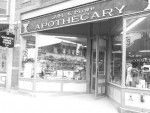Keeping Tradition Alive

In 1869, Colgate celebrated its 50th birthday. Ebenezer Dodge began his tenure as University President. The University endowment added up to more than $180,000. Tuition, fees and board totaled $168. East, West and Alumni Halls composed the student campus. Theta Chi Fraternity was home to the Hamilton Female Seminary, a finishing school for girls. Chenango Canal was fully operational; there was an opera house where the movie theatre now stands. A Congregational Church – with the dubious distinction of a workman being killed while hanging its bell and the steeple blowing down during fierce weather – stood on the site of the present post office.
1869 also marked the establishment of the longest-running independent business in Hamilton, Crowe’s Pharmacy. Back then, it was called Root’s Pharmacy, owned by a man named Elmer C. Root and it occupied a space in the Smith Building where the present strip of stores that include Rosita’s, Parkside and P.M Jones now stand.
The fire of 1895 almost destroyed the entire business district, forcing merchants to set up a temporary “Shantytown” in the village green until reconstruction was completed the following year. The pharmacy took up residence once again in the Smith Building until moving to its present location on Lebanon Street in the early 1900s, replacing a grocery store that had been there since the post-1895 fire reconstruction.
J.H. Crowe took ownership of the store in 1919 and remained its proprietor until 1960 when he sold it to Robert “Bob” McGaugh. Bob retired in 1999 and turned the store over to his son, Pat McGaugh, its present-day owner.
Pat has worked at his father’s pharmacy since the age of 10. Growing up, his father was a devoted Colgate hockey fan, winning the Silver Puck from the Hockey Booster Program in 1989. A good friend of Terry Slater, the head coach until 1992, Bob and his friends would watch the hockey games down at the drug store before cable was available throughout town.
Pat was a devoted fan as well. He remembers a moment with Michael Milbury ’73 who went on to play in the National Hockey League.
“We would ask for the hockey sticks of the players after the game and most of the time they would say no” Pat said. So I decided to ask Michael Milbury for his stick before the game. He said to me, How would you like this stick right across your nose? [It] changed my life – I’ll never forget it.”
It’s hard not to be reminded of how long Crowe’s has been around. After all, the sign above the window reads Apothecary, requiring the casual passersby to recollect one of the classic novels they’ve read to remember the word’s meaning. A good portion of the interior of the store is dedicated to showcasing vestiges of the past with an interesting array of antique pharmaceutical equipment, compounds, bottles and even books of handwritten prescriptions dating back to 1895, the year of the fire. Nonetheless, the store, along with the pharmacy industry, has undergone many changes since its establishment in 1869.
Crowe’s, largely due to its unique small town locale and clientele, still retains that corner drug store feel. Even its business cards read, “Same as it ever was.” But rather than the days when everything was made in shop – tablets rolled, ointments mixed and capsules filled – these days, the local pharmacist is more likely to be found counting pills and figuring out insurance coverage. And, according to Pat, “Most students don’t know a thing about their insurance.”
The opening of Kinney’s Drugstore has not affected business in the least. He can depend on his loyal customer base, of which Colgate students make up 50 percent. As for the new student housing being built and the Hamilton Initiative, Pat is unsure how it will affect business, commenting it could go either way.
Pat attests, “Being a pharmacist in a town like this, owning your own store, this is as good as it can get.” If history serves as guide, it’s likely Crowe’s will weather whatever changes may be ahead for a long time to come.



